RENAULT FLUENCE 2012 1.G Owners Manual
Manufacturer: RENAULT, Model Year: 2012, Model line: FLUENCE, Model: RENAULT FLUENCE 2012 1.GPages: 241, PDF Size: 6.5 MB
Page 181 of 241
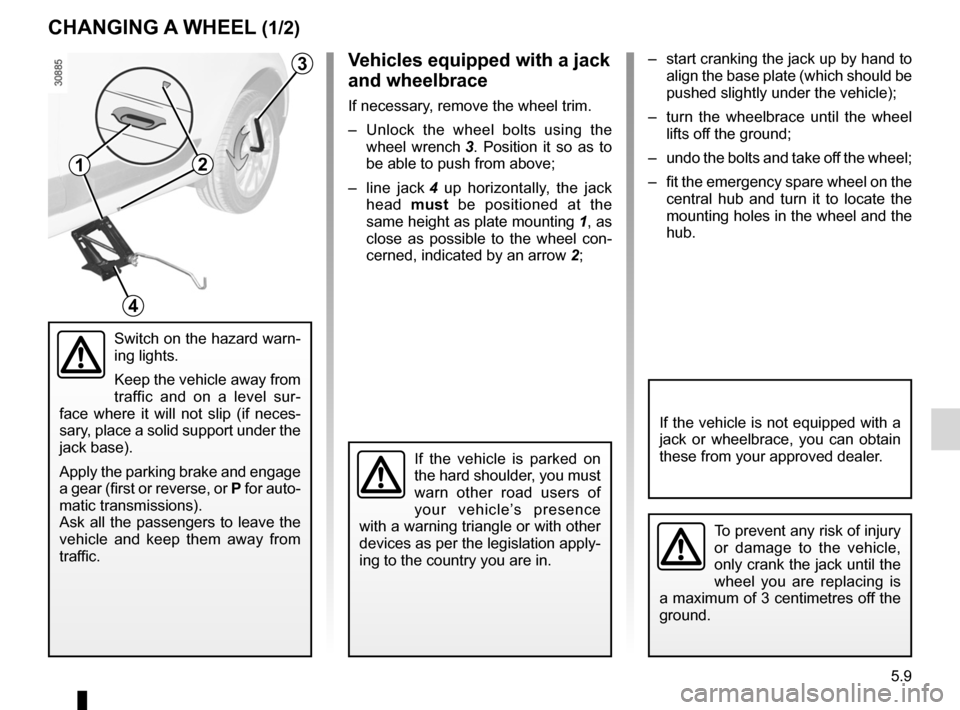
changing a wheel.................................. (up to the end of the DU)
puncture ................................................ (up to the end of the DU)
lifting the vehicle changing a wheel ............................ (up to the end of the DU)
5.9
ENG_UD21374_3
Changement de roue (L38 - X38 - Renault)
ENG_NU_891_892-7_L38-B32_Renault_5
Vehicles equipped with a jack
and wheelbrace
If necessary, remove the wheel trim.
– Unlock the wheel bolts using the
wheel wrench 3. Position it so as to
be able to push from above;
– line jack 4 up horizontally, the jack
head must be positioned at the
same height as plate mounting 1, as
close as possible to the wheel con -
cerned, indicated by an arrow 2;
– start cranking the jack up by hand to
align the base plate (which should be
pushed slightly under the vehicle);
– turn the wheelbrace until the wheel
lifts off the ground;
– undo the bolts and take off the wheel;
– fit the emergency spare wheel on the
central hub and turn it to locate the
mounting holes in the wheel and the
hub.
Changing a wheel
changIng a wheel (1/2)
Switch on the hazard warn-
ing lights.
Keep the vehicle away from
traffic and on a level sur -
face where it will not slip (if neces -
sary, place a solid support under the
jack base).
Apply the parking brake and engage
a gear (first or reverse, or P for auto-
matic transmissions).
Ask all the passengers to leave the
vehicle and keep them away from
traffic.
3
4
12
To prevent any risk of injury
or damage to the vehicle,
only crank the jack until the
wheel you are replacing is
a maximum of 3 centimetres off the
ground.
If the vehicle is not equipped with a
jack or wheelbrace, you can obtain
these from your approved dealer.
If the vehicle is parked on
the hard shoulder, you must
warn other road users of
your vehicle’s presence
with a warning triangle or with other
devices as per the legislation apply-
ing to the country you are in.
Page 182 of 241
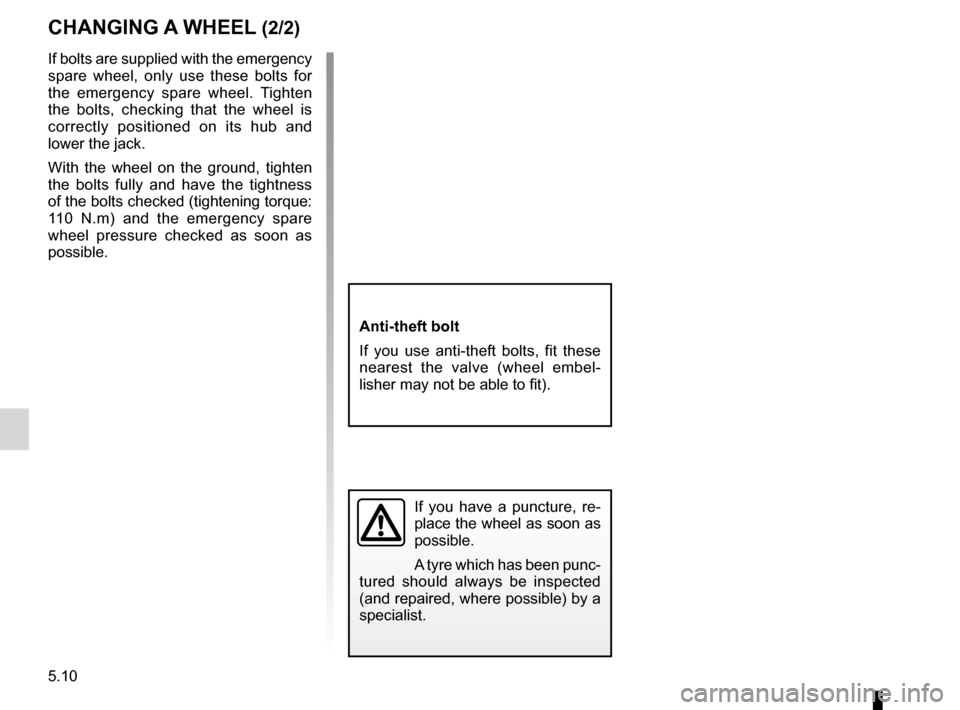
5.10
ENG_UD21374_3
Changement de roue (L38 - X38 - Renault)
ENG_NU_891_892-7_L38-B32_Renault_5
changIng a wheel (2/2)
If you have a puncture, re -
place the wheel as soon as
possible.
A tyre which has been punc-
tured should always be inspected
(and repaired, where possible) by a
specialist.
anti-theft bolt
If you use anti-theft bolts, fit these
nearest the valve (wheel embel -
lisher may not be able to fit).
If bolts are supplied with the emergency
spare wheel, only use these bolts for
the emergency spare wheel. Tighten
the bolts, checking that the wheel is
correctly positioned on its hub and
lower the jack.
With the wheel on the ground, tighten
the bolts fully and have the tightness
of the bolts checked (tightening torque:
110 N.m) and the emergency spare
wheel pressure checked as soon as
possible.
Page 183 of 241
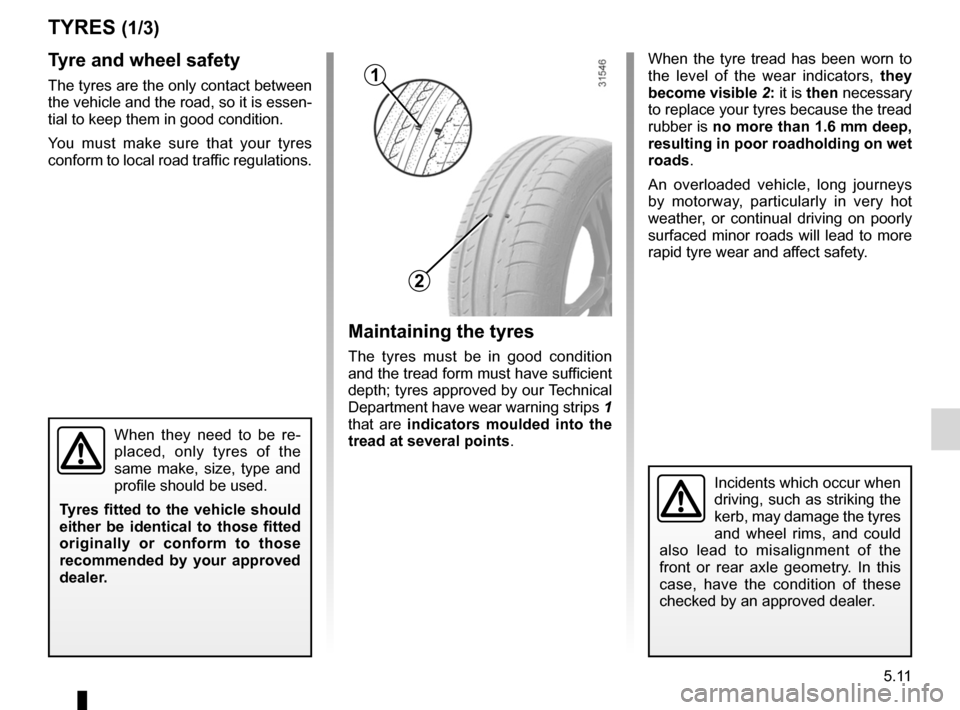
tyres ...................................................... (up to the end of the DU)
wheels (safety) ..................................... (up to the end of the DU)
5.11
ENG_UD21376_2
Pneumatiques (L38 - X38 - Renault)
ENG_NU_891_892-7_L38-B32_Renault_5
Tyres (tyre and wheel safety, use in winter)
tyres (1/3)
maintaining the tyres
The tyres must be in good condition
and the tread form must have sufficient
depth; tyres approved by our Technical
Department have wear warning strips 1
that are indicators moulded into the
tread at several points.
t yre and wheel safety
The tyres are the only contact between
the vehicle and the road, so it is essen-
tial to keep them in good condition.
You must make sure that your tyres
conform to local road traffic regulations. When the tyre tread has been worn to
the level of the wear indicators,
they
become visible 2: it is then necessary
to replace your tyres because the tread
rubber is no more than 1.6 mm deep,
resulting in poor roadholding on wet
roads.
An overloaded vehicle, long journeys
by motorway, particularly in very hot
weather, or continual driving on poorly
surfaced minor roads will lead to more
rapid tyre wear and affect safety.
When they need to be re -
placed, only tyres of the
same make, size, type and
profile should be used.
t yres fitted to the vehicle should
either be identical to those fitted
originally or conform to those
recommended by your approved
dealer.
Incidents which occur when
driving, such as striking the
kerb, may damage the tyres
and wheel rims, and could
also lead to misalignment of the
front or rear axle geometry. In this
case, have the condition of these
checked by an approved dealer.
2
1
Page 184 of 241

tyre pressure.......................................................... (current page)
5.12
ENG_UD21376_2
Pneumatiques (L38 - X38 - Renault)
ENG_NU_891_892-7_L38-B32_Renault_5
Jaune NoirNoir texte
tyre pressuresAdhere to the tyre pressures (including
the emergency spare wheel). The tyre
pressures should be checked at least
once a month and additionally before
any long journey (refer to the label af -
fixed to the edge of the driver’s door). Pressures should be checked when the
tyres are cold; ignore higher pressures
which may be reached in hot weather
or following a fast journey.
If tyre pressures cannot be checked
when the tyres are
cold, the normal
pressures must be increased by 0.2 to
0.3 bar (or 3 PsI).
never deflate a hot tyre.
special note
Depending on the vehicle, there may
be an adapter which needs to be posi-
tioned on the valve before air is added.Fitting new tyres
emergency spare wheel
Refer to the information on the
“Emergency spare wheel” and in -
structions on “Changing a wheel” in
Section 5.
tyres (2/3)
Incorrect tyre pressures
lead to abnormal tyre wear
and unusually hot running.
These are factors which
may seriously affect safety and lead
to:
– poor road holding,
– risk of bursting or tread separa -
tion.
The pressure depends on the load
and the speed of use. Adjust the
pressure according to the condi -
tions of use (refer to the label affixed
to the edge of the driver’s door).
Please be aware that a
poorly tightened or miss -
ing valve cap can make the
tyres less airtight and lead
to pressure loss.
Always use valve caps identical to
those fitted originally and tighten
them fully.
For safety reasons, this op-
eration must be carried out
by a specialist.
Fitting different tyres may
change your vehicle as follows:
– It may mean that your vehicle no
longer conforms to current regu-
lations;
– It may change the way it handles
when cornering;
– It may cause the steering to be
heavy;
– It may affect the use of snow
chains.
Page 185 of 241
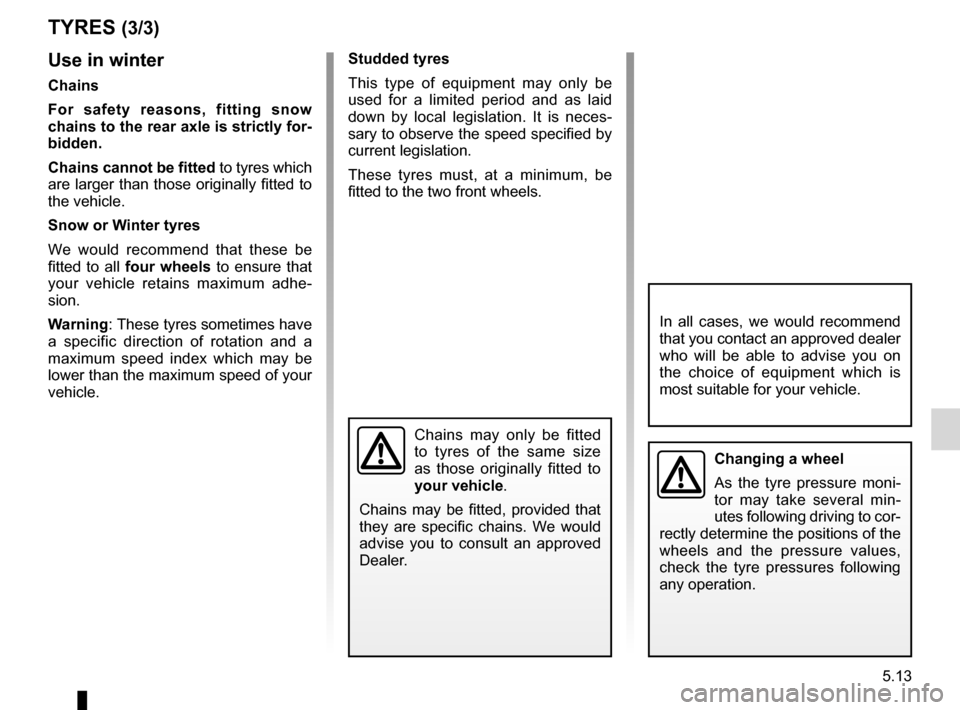
JauneNoirNoir texte
5.13
ENG_UD21376_2
Pneumatiques (L38 - X38 - Renault)
ENG_NU_891_892-7_L38-B32_Renault_5
use in winter
chains
For safety reasons, fitting snow
chains to the rear axle is strictly for-
bidden.
chains cannot be fitted to tyres which
are larger than those originally fitted to
the vehicle.
snow or w inter tyres
We would recommend that these be
fitted to all four wheels to ensure that
your vehicle retains maximum adhe -
sion.
w arning: These tyres sometimes have
a specific direction of rotation and a
maximum speed index which may be
lower than the maximum speed of your
vehicle.
tyres (3/3)
Chains may only be fitted
to tyres of the same size
as those originally fitted to
your vehicle.
Chains may be fitted, provided that
they are specific chains. We would
advise you to consult an approved
Dealer.
In all cases, we would recommend
that you contact an approved dealer
who will be able to advise you on
the choice of equipment which is
most suitable for your vehicle.
changing a wheel
As the tyre pressure moni -
tor may take several min -
utes following driving to cor-
rectly determine the positions of the
wheels and the pressure values,
check the tyre pressures following
any operation.
studded tyres
This type of equipment may only be
used for a limited period and as laid
down by local legislation. It is neces -
sary to observe the speed specified by
current legislation.
These tyres must, at a minimum, be
fitted to the two front wheels.
Page 186 of 241
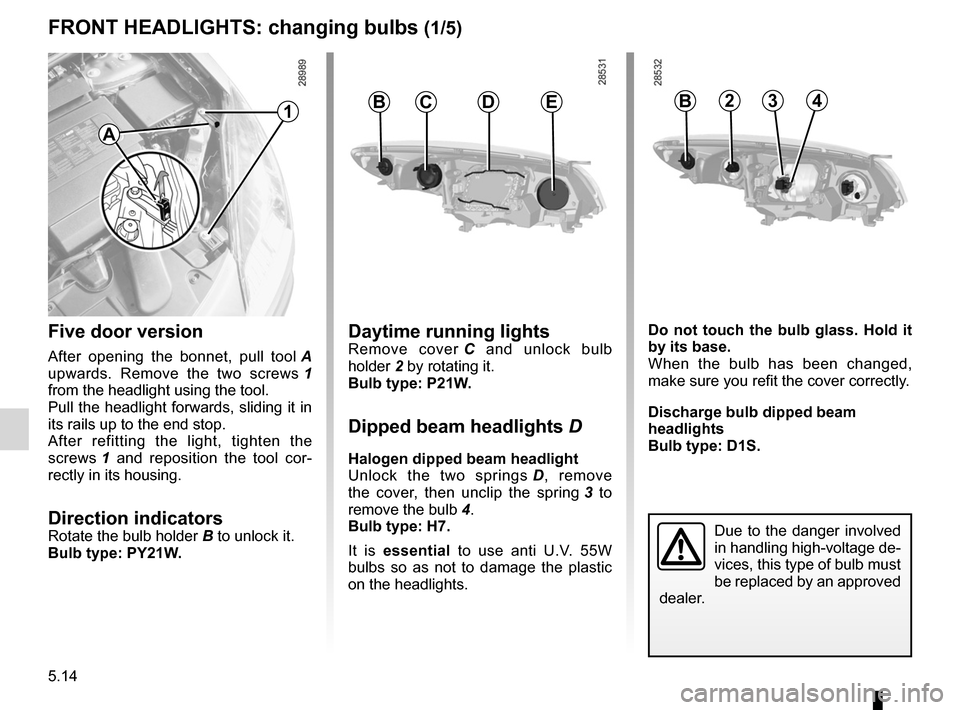
lightsfront ................................................. (up to the end of the DU)
lights changing bulbs ................................ (up to the end of the DU)
changing a bulb .................................... (up to the end of the DU)
indicators .............................................. (up to the end of the DU)
bulbs changing ......................................... (up to the end of the DU)
lights: dipped beam headlights .................. (up to the end of the DU)
lights: direction indicators .......................... (up to the end of the DU)
lights: main beam headlights ..................... (up to the end of the DU)
bulbs changing ......................................... (up to the end of the DU)
5.14
ENG_UD27193_5
Projecteurs avant : remplacement des lampes (L38 - X38 - Renault)
ENG_NU_891_892-7_L38-B32_Renault_5
Jaune NoirNoir texte
Do not touch the bulb glass. hold it
by its base.
When the bulb has been changed,
make sure you refit the cover correctly.
Discharge bulb dipped beam
headlights
Bulb type: D1s.
Headlights (changing bulbs)
FrOnt heaDlIghts: changing bulbs (1/5)
Five door version
After opening the bonnet, pull tool A
upwards. Remove the two screws 1
from the headlight using the tool.
Pull the headlight forwards, sliding it in
its rails up to the end stop.
After refitting the light, tighten the
screws 1 and reposition the tool cor -
rectly in its housing.
Direction indicatorsRotate the bulb holder B to unlock it.
Bulb type: Py21w .
Daytime running lightsRemove cover C and unlock bulb
holder 2 by rotating it.
Bulb type: P21w .
Dipped beam headlights D
halogen dipped beam headlight
Unlock the two springs D , remove
the cover, then unclip the spring 3 to
remove the bulb 4.
Bulb type: h7.
It is essential to use anti U.V. 55W
bulbs so as not to damage the plastic
on the headlights.
1BcDe324B
Due to the danger involved
in handling high-voltage de-
vices, this type of bulb must
be replaced by an approved
dealer.
a
Page 187 of 241
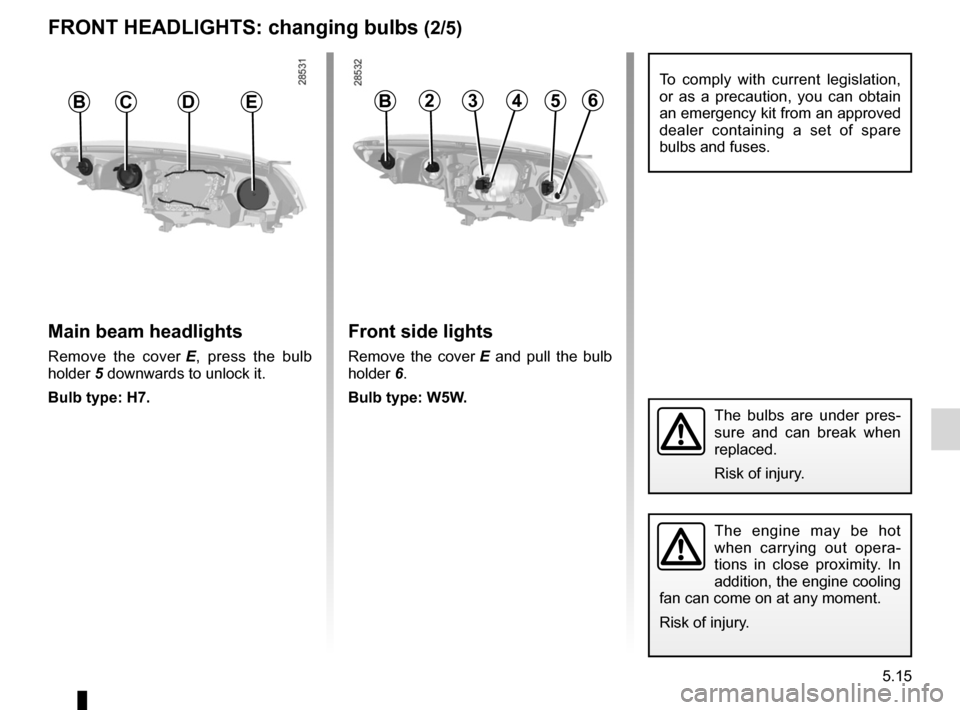
JauneNoirNoir texte
5.15
ENG_UD27193_5
Projecteurs avant : remplacement des lampes (L38 - X38 - Renault)
ENG_NU_891_892-7_L38-B32_Renault_5
The engine may be hot
when carrying out opera -
tions in close proximity. In
addition, the engine cooling
fan can come on at any moment.
Risk of injury.
The bulbs are under pres -
sure and can break when
replaced.
Risk of injury.
To comply with current legislation,
or as a precaution, you can obtain
an emergency kit from an approved
dealer containing a set of spare
bulbs and fuses.
FrOnt heaDlIghts: changing bulbs (2/5)
main beam headlights
Remove the cover E , press the bulb
holder 5 downwards to unlock it.
Bulb type: h7.
BcDe3245B6
Front side lights
Remove the cover E and pull the bulb
holder 6.
Bulb type: w5w .
Page 188 of 241
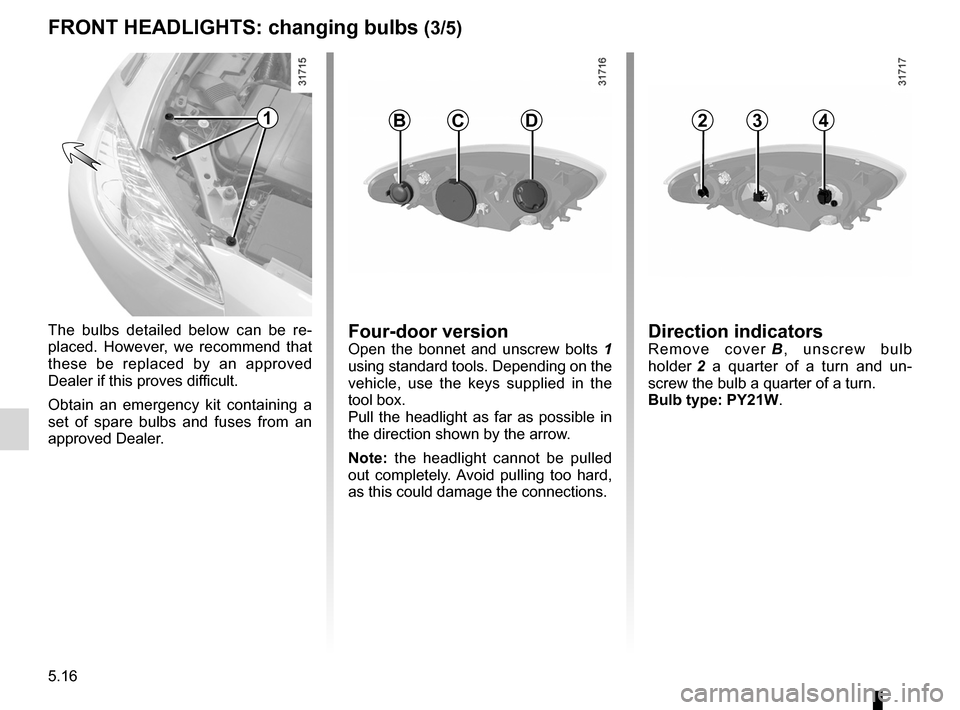
5.16
ENG_UD27193_5
Projecteurs avant : remplacement des lampes (L38 - X38 - Renault)
ENG_NU_891_892-7_L38-B32_Renault_5
Jaune NoirNoir texte
FrOnt heaDlIghts: changing bulbs (3/5)
Direction indicators
R e m o v e c o v e r B , u n s c r e w b u l b
holder 2 a quarter of a turn and un -
screw the bulb a quarter of a turn.
Bulb type: Py21w.Four-door versionOpen the bonnet and unscrew bolts 1
using standard tools. Depending on the
vehicle, use the keys supplied in the
tool box.
Pull the headlight as far as possible in
the direction shown by the arrow.
n ote: the headlight cannot be pulled
out completely. Avoid pulling too hard,
as this could damage the connections.
BcD2431
The bulbs detailed below can be re -
placed. However, we recommend that
these be replaced by an approved
Dealer if this proves difficult.
Obtain an emergency kit containing a
set of spare bulbs and fuses from an
approved Dealer.
Page 189 of 241
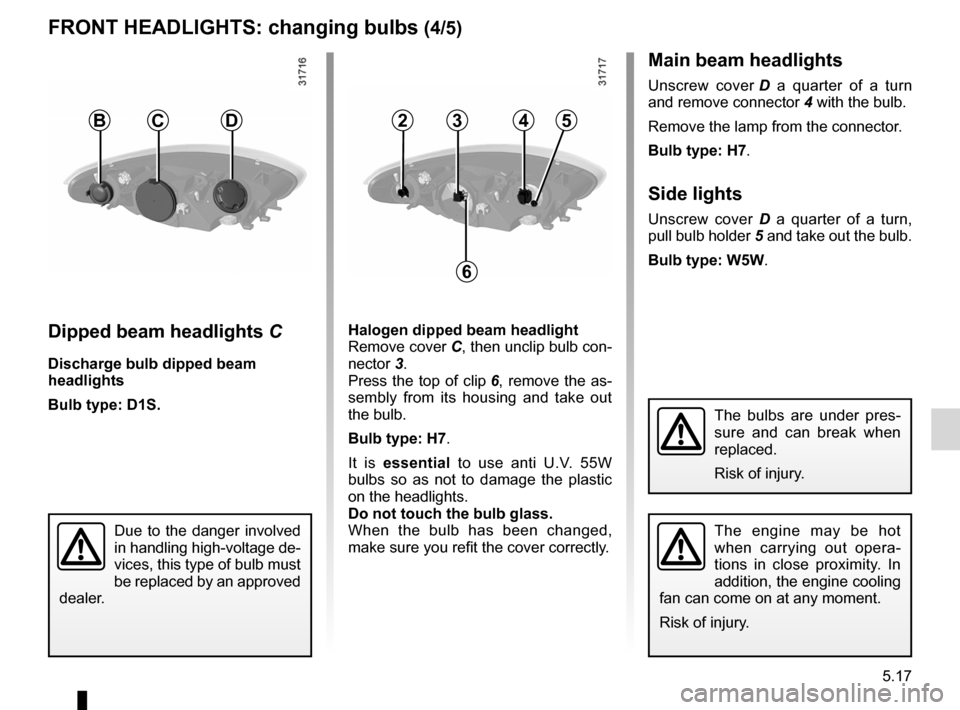
JauneNoirNoir texte
5.17
ENG_UD27193_5
Projecteurs avant : remplacement des lampes (L38 - X38 - Renault)
ENG_NU_891_892-7_L38-B32_Renault_5
FrOnt heaDlIghts: changing bulbs (4/5)
halogen dipped beam headlight
Remove cover C, then unclip bulb con-
nector 3.
Press the top of clip 6, remove the as-
sembly from its housing and take out
the bulb.
Bulb type: h7.
It is essential to use anti U.V. 55W
bulbs so as not to damage the plastic
on the headlights.
Do not touch the bulb glass.
When the bulb has been changed,
make sure you refit the cover correctly.
main beam headlights
Unscrew cover D a quarter of a turn
and remove connector 4 with the bulb.
Remove the lamp from the connector.
Bulb type: h7.
side lights
Unscrew cover D a quarter of a turn,
pull bulb holder 5 and take out the bulb.
Bulb type: w5w.
BcD2543
6
Due to the danger involved
in handling high-voltage de-
vices, this type of bulb must
be replaced by an approved
dealer.
Dipped beam headlights C
Discharge bulb dipped beam
headlights
Bulb type: D1s.
The bulbs are under pres -
sure and can break when
replaced.
Risk of injury.
The engine may be hot
when carrying out opera -
tions in close proximity. In
addition, the engine cooling
fan can come on at any moment.
Risk of injury.
Page 190 of 241
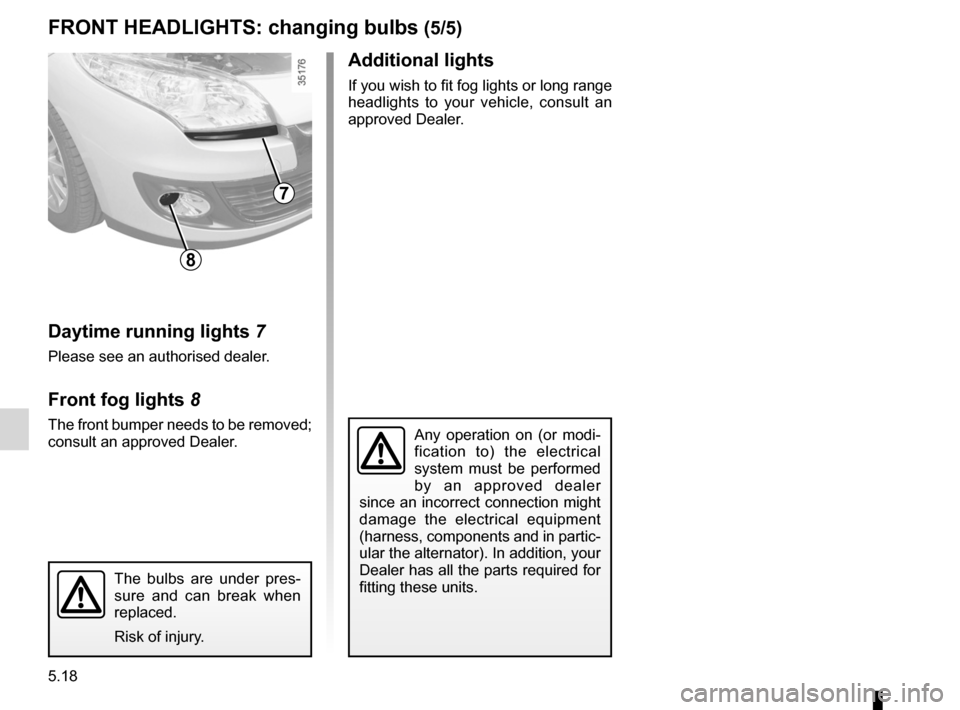
fog lights ................................................................ (current page)
lights: fog lights .......................................................... (current page)
lights additional ......................................................... (current page)
lights fog lights .......................................................... (current page)
5.18
ENG_UD27193_5
Projecteurs avant : remplacement des lampes (L38 - X38 - Renault)
ENG_NU_891_892-7_L38-B32_Renault_5
additional lights
If you wish to fit fog lights or long range
headlights to your vehicle, consult an
approved Dealer.
Any operation on (or modi -
fication to) the electrical
system must be performed
by an approved dealer
since an incorrect connection might
damage the electrical equipment
(harness, components and in partic-
ular the alternator). In addition, your
Dealer has all the parts required for
fitting these units.
The bulbs are under pres -
sure and can break when
replaced.
Risk of injury.
7
Daytime running lights 7
Please see an authorised dealer.
Front fog lights 8
The front bumper needs to be removed;
consult an approved Dealer.
FrOnt heaDlIghts: changing bulbs (5/5)
8